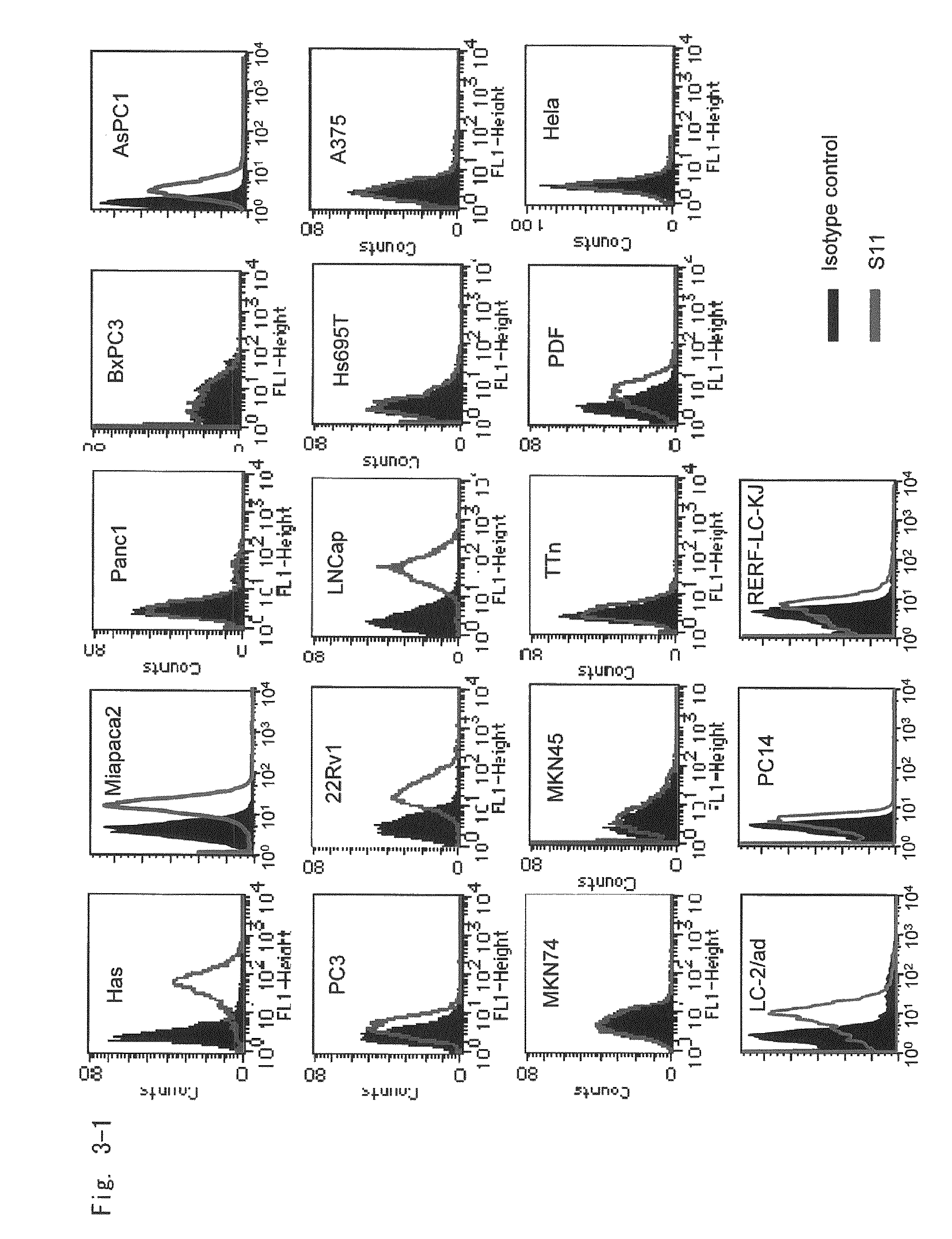Antibody directed against PAP2a and use thereof for diagnostic and therapeutic purposes
a technology of antibody and pap2a, which is applied in the field of antibody against pap2a, can solve the problems of hardly infecting adenovirus, poor expression of car in pancreatic cancer cells, and ineffective topical administration for patients with metastatic disease, etc., and achieve the effect of enhancing gene transfer efficiency
- Summary
- Abstract
- Description
- Claims
- Application Information
AI Technical Summary
Benefits of technology
Problems solved by technology
Method used
Image
Examples
example 1
Production of Adenovirus FZ33 Series
[0317]In the laboratory of the inventors, FZ33 variant adenovirus was produced by genetic engineering using the materials and procedures described in Yoshida, et al. (Yoshida, et al., Human Gene Therapy, 9(17): 2503-2515, 1998), Nakamura, et al. (Nakamura, T., et al., Hum. Gene Ther., 13(5): 613-626, 2002), etc., basically in accordance with the method of Volpers, et al. (Volpers, C., et al., J. Virol., 77: 2093-2104, 2003). The amino acid sequence Z33 reported by Braisted et al., (Braisted, A. C. and Wells, J. A., Proc. Natl. Acad. Sci. USA, 93: 5688-5692, 1996) was used as the sequence of FZ33 motif.
A. Production of Plasmid pAx3 Containing an RGD-Modified Fiber and the Genome at the Left End of Adenovirus
[0318]FIG. 13-1 is a schematic representation of plasmid vector pAx3 for producing recombinant adenovirus as a representative example in the present invention. The pAx3 plasmid contains 357 bp from the left end nt1-357 of the genome in human typ...
example 2
Construction of Monoclonal Antibody Library
[0378]BALB / c mice were immunized with the hamster cell line Has cells to construct a library of monoclonal antibodies against Has cells. More specifically, approximately a million of Has cells were intraperitoneally administered to BALB / c mice every 1 week or every 2 weeks 4 times or more. For final immunization (booster), mice were intravenously injected with the same amount of cells via the tail vein. Three days after the final booster immunization, cell fusion was performed using mouse myeloma cells (P3U1) and polyethylene glycol to generate hybridomas. All manipulations including procedures of cell fusion, selection of hybridomas in HAT selection media, subcloning of hybridomas, method of inducing ascites cancer in mice by intraperitoneal injection of hybridomas in mice, purification of mouse immunoglobulin from mouse ascites, etc. were all performed by the standard methods already reported (e.g., Hamada, H. and Tsuruo, T., PNAS, 83(20)...
example 3
Screening of Targeted Antibody
Staining and Chemiluminescence Assay of Beta-Galactosidase
[0381]The resulting antibody (hybridoma supernatant) was reacted with Has cells, which had been previously seeded in a 96-well plate, and then infected with FZ33 fiber-modified adenovirus Ax3CAZ3-FZ33 expressing LacZ as a reporter gene. After twenty four hours or 48 hours, expression was confirmed by chemiluminescent β-Gal reporter gene assay and overexpressed hybridomas were cloned. Subcloning was repeated twice and clones of the hybridomas obtained from two different clones were named S11 and T13, respectively. The S11 and T13 hybridomas were deposited on Apr. 8, 2005 with National Institute of Advanced Industrial Science and Technology, International Patent Organism Depositary (IPOD) under FERM P-20499 and FERM P-20498, respectively.
[0382]The procedures are described below more specifically.
(1) Day −1:
[0383]Has cells are seeded in a 96-well plate at 3×103 cells / well.
(2) Day 0:[0384]The hybrido...
PUM
| Property | Measurement | Unit |
|---|---|---|
| binding constant | aaaaa | aaaaa |
| binding constant | aaaaa | aaaaa |
| binding constant | aaaaa | aaaaa |
Abstract
Description
Claims
Application Information
 Login to View More
Login to View More - R&D
- Intellectual Property
- Life Sciences
- Materials
- Tech Scout
- Unparalleled Data Quality
- Higher Quality Content
- 60% Fewer Hallucinations
Browse by: Latest US Patents, China's latest patents, Technical Efficacy Thesaurus, Application Domain, Technology Topic, Popular Technical Reports.
© 2025 PatSnap. All rights reserved.Legal|Privacy policy|Modern Slavery Act Transparency Statement|Sitemap|About US| Contact US: help@patsnap.com



